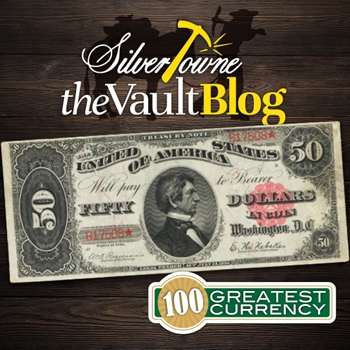
Behind every coin, every currency note, and every numismatic item there is a story. Perhaps that is what makes them so valuable intrinsically and perhaps that is more so why we are so fascinated by them. When we buy coins and currency, we inherit stories and continue to pass them on. The rarest of numismatic gems have arguably some of the most interesting of stories, even if it’s just because of the person on them and not the year and issue specifically.
In our next journey exploring Whitman Publishing’s 100 Greatest American Currency Notes publication, we take a closer look at a middle of the pack entry that deems itself a classic rarity. Authors Q. David Bowers and David M. Sundman help us understand the importance of not only the note but the portrait of the man who is on the face of it.
#56 - William H. Seward Portrait $50 Treasury or Coin Note, Series of 1891
Right off the bat, authors Bowers and Sundman make us aware of the rarity of this note. The $50 note from the series of 1891 had a total of 80,000 printed. However, of that number, only 23,500 were distributed and around 25 were said to have been “outstanding on Treasury records.” There is a question of the legitimacy of that said 25 though as Martin Gengerke, publisher of his U.S. Paper Money Records, documents 21 different notes that made it into the hands of numismatists. Because of this, the 25 said to have been outstanding are too high of a number according to the authors.
Aside from the number produced and so forth of the $50 Series 1891 note, what is perhaps even more important is the man featured on the face of them: William H. Seward. During the night of President Abraham Lincoln’s assassination, Seward, who was Lincoln’s Secretary of State, was also facing an assassination attempt. John Wilkes Booth’s unfortunate success at Ford Theatre on the night of April 14, 1865, featured a co-conspirator by the name of Lewis Thornton Powell that tried to take the life of Seward as well. While lying in bed with an illness, Seward suffered several knife wounds to both his face and neck. Seward’s son Frederick and three other members of the house were stabbed also trying to protect him.
The portrait of Seward on the face of the $50 note from 1891 represented the man, a strong and vitally important man, before the assassination. After surviving the attempt on his life, Seward aged and weakened understandably so. While the importance of his life being spared plays a role in the appeal of the note, it is not, however, the reason he is commemorated. It comes as no surprise that he was a member of President Lincoln’s cabinet as he was a strong advocate and supporter of prison and education reform in addition to his anti-slavery beliefs. He is most notably known for his acquisition of what is now recognized as the state of Alaska. At the time of this negotiation with Russia, it was Seward that played a major role in the purchase of the state for $7.2 million in 1867 under President Andrew Johnson. While he was widely criticized for his role in this event, it would turn out to be an important step for the United States.
The historic market value for this note in a Very Fine condition was valued at $2,500 in 1960. Twenty years later, it increased to $20,000. By 2006, it reached $45,000. A Gem Crisp Uncirculated version reaches well beyond $100,000.







